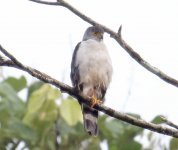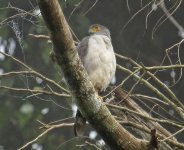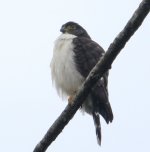megan perkins
Well-known member
This pair of raptors was sighted in Mitu, Vaupes dept, Colombia.
They were perched high in a tree early morning, drying out after a wet night. Initial Id by our guide was Slaty-backed Forest-falcon (which I am sure they are not). Most likely seems Bicolored Hawk, but I cannot see any rufous thighs visible in any of my pic's. Also considered Grey-bellied Goshawk (Accipiter poliogaster), but shape and appearance seem wrong?
I would appreciate any thoughts on this
Many thanks


They were perched high in a tree early morning, drying out after a wet night. Initial Id by our guide was Slaty-backed Forest-falcon (which I am sure they are not). Most likely seems Bicolored Hawk, but I cannot see any rufous thighs visible in any of my pic's. Also considered Grey-bellied Goshawk (Accipiter poliogaster), but shape and appearance seem wrong?
I would appreciate any thoughts on this
Many thanks









